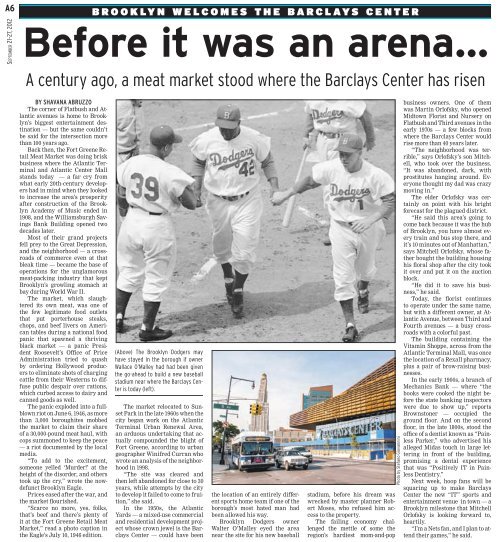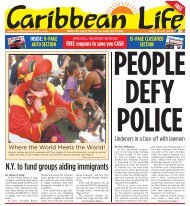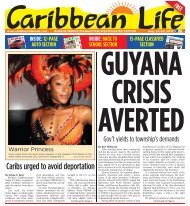Print edition (PDF) - Caribbean Life
Print edition (PDF) - Caribbean Life
Print edition (PDF) - Caribbean Life
- No tags were found...
Create successful ePaper yourself
Turn your PDF publications into a flip-book with our unique Google optimized e-Paper software.
A6BROOKLYN WELCOMES THE BARCLAYS CENTERSEPTEMBER 21–27, 2012Before it was an arena…A century ago, a meat market stood where the Barclays Center has risenBY SHAVANA ABRUZZOThe corner of Flatbush and Atlanticavenues is home to Brooklyn’sbiggest entertainment destination— but the same couldn’tbe said for the intersection morethan 100 years ago.Back then, the Fort Greene RetailMeat Market was doing briskbusiness where the Atlantic Terminaland Atlantic Center Mallstands today — a far cry fromwhat early 20th-century developershad in mind when they lookedto increase the area’s prosperityafter construction of the BrooklynAcademy of Music ended in1908, and the Williamsburgh SavingsBank Building opened twodecades later.Most of their grand projectsfell prey to the Great Depression,and the neighborhood — a crossroadsof commerce even at thatbleak time — became the base ofoperations for the unglamorousmeat-packing industry that keptBrooklyn’s growling stomach atbay during World War II.The market, which slaughteredits own meat, was one ofthe few legitimate food outletsthat put porterhouse steaks,chops, and beef livers on Americantables during a national foodpanic that spawned a thrivingblack market — a panic PresidentRoosevelt’s Office of PriceAdministration tried to quashby ordering Hollywood producersto eliminate shots of chargingcattle from their Westerns to diffusepublic despair over rations,which curbed access to dairy andcanned goods as well.The panic exploded into a fullblownriot on June 6, 1946, as morethan 3,000 boroughites mobbedthe market to claim their shareof a 30,000-pound meat haul, withcops summoned to keep the peace— a riot documented by the localmedia.“To add to the excitement,someone yelled ‘Murder!’ at theheight of the disorder, and otherstook up the cry,” wrote the nowdefunctBrooklyn Eagle.Prices eased after the war, andthe market flourished.“Scarce no more, yes, folks,that’s beef and there’s plenty ofit at the Fort Greene Retail MeatMarket,” read a photo caption inthe Eagle’s July 10, 1946 <strong>edition</strong>.(Above) The Brooklyn Dodgers mayhave stayed in the borough if ownerWallace O’Malley had had been giventhe go-ahead to build a new baseballstadium near where the Barclays Centeris today (left).The market relocated to SunsetPark in the late 1960s when thecity began work on the AtlanticTerminal Urban Renewal Area,an arduous undertaking that actuallycompounded the blight ofFort Greene, according to urbangeographer Winifred Curran whowrote an analysis of the neighborhoodin 1998.“The site was cleared andthen left abandoned for close to 30years, while attempts by the cityto develop it failed to come to fruition,”she said.In the 1950s, the AtlanticYards — a mixed-use commercialand residential development projectwhose crown jewel is the BarclaysCenter — could have beenthe location of an entirely differentsports home team if one of theborough’s most hated man hadbeen allowed his way.Brooklyn Dodgers ownerWalter O’Malley eyed the areanear the site for his new baseballstadium, before his dream waswrecked by master planner RobertMoses, who refused him accessto the property.The failing economy challengedthe mettle of some theregion’s hardiest mom-and-popPhoto by Stefano Giovanninibusiness owners. One of themwas Martin Orlofsky, who openedMidtown Florist and Nursery onFlatbush and Third avenues in theearly 1970s — a few blocks fromwhere the Barclays Center wouldrise more than 40 years later.“The neighborhood was terrible,”says Orlofsky’s son Mitchell,who took over the business.“It was abandoned, dark, withprostitutes hanging around. Everyonethought my dad was crazymoving in.”The elder Orlofsky was certainlyon point with his brightforecast for the plagued district.“He said this area’s going tocome back because it was the hubof Brooklyn, you have almost everytrain and bus stop there, andit’s 10 minutes out of Manhattan,”says Mitchell Orlofsky, whose fatherbought the building housinghis floral shop after the city tookit over and put it on the auctionblock.“He did it to save his business,”he said.Today, the florist continuesto operate under the same name,but with a different owner, at AtlanticAvenue, between Third andFourth avenues — a busy crossroadswith a colorful past.The building containing theVitamin Shoppe, across from theAtlantic Terminal Mall, was oncethe location of a Rexall pharmacy,plus a pair of brow-raising businesses.In the early 1900s, a branch ofMechanics Bank — where “thebooks were cooked the night beforethe state banking inspectorswere due to show up,” reportsBrownstoner — occupied theground floor. And on the secondfloor, in the late 1800s, stood theoffice of a dentist known as “PainlessParker,” who advertised hisalleged Midas touch in large letteringin front of the building,promising a dental experiencethat was “Positively IT in PainlessDentistry.”Next week, hoop fans will besquaring up to make BarclaysCenter the new “IT” sports andentertainment venue in town — aBrooklyn milestone that MitchellOrlofsky is looking forward to,heartily.“I’m a Nets fan, and I plan to attendtheir games,” he said.









